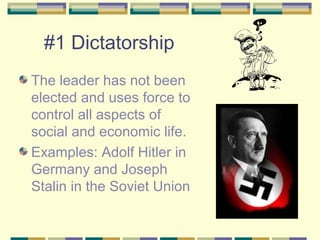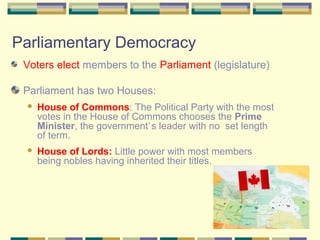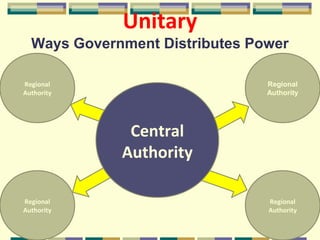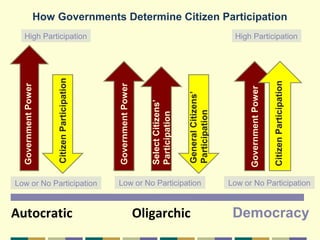Government ppt
- 2. To study governments, geographers look at the following: Types – Who rules and who participates? Systems – How the power is distributed?
- 3. Types of Government are based on one key question: Who governs and what is the citizen participation? There are three types of governments: Autocracy, Oligarchy, and Democracy
- 4. Autocracy Government in which the power to govern is held by one person. Generally the power to rule is inherited or by military force. There are three types of Autocracy.
- 5. #1 Dictatorship The leader has not been elected and uses force to control all aspects of social and economic life. Examples: Adolf Hitler in Germany and Joseph Stalin in the Soviet Union
- 6. #2 Absolute Monarchy Brunei, Oman, Saudi Arabia and Vatican City. A monarchy has a king, queen, emperor or empress. The power is usually inherited or passed down from family members. The monarch has absolute power meaning they can make all decisions without consulting anyone.
- 7. #3 Constitutional Monarchy Kings, queens or emperors share power with elected legislatures. Generally they are nothing more than figureheads (ceremonial). The government is a democratic one that limits the monarchs power. Example: Great Britain
- 8. Oligarchy A government in which a few people such as a dominant clan or clique have power. The group gets their power from either military, wealth or social status. Elections may be held but offer only one candidate. Example: Greek city states Caudillos - those who owned large estates throughout Sparta the land.
- 9. Democracy In a democracy, the government is “Ruled by the people” There are two forms of democracy Direct Democracy – People vote on all the issues. Representative Democracy – People elect representatives and give them the power to vote on issues. Example: United States
- 10. In a democracy…. Individual freedom and equality is valued. Free elections are held Decisions are based on majority rule. All candidates can express their views freely. Citizens vote by secret ballot.
- 11. Democratic Governments There are two major kinds of democratic governments: Parliamentary Presidential
- 12. Parliamentary Democracy Voters elect members to the Parliament (legislature) Parliament has two Houses: House of Commons: The Political Party with the most votes in the House of Commons chooses the Prime Minister, the government’ s leader with no set length of term. House of Lords: Little power with most members being nobles having inherited their titles.
- 13. Presidential Democracy Voters elect legislators Voters elect (indirectly) the president. Therefore, in the presidential system voters have a more direct say about those who serve in two branches of the government : Legislative Executive
- 14. Parliamentary Presidential System System Executive Executive Legislative Select Elec Elec Elec t Legislative t t Elect Citizens Citizens
- 15. Systems of Government are based on one question: How is the power distributed? There are three ways governments distribute power: Unitary Confederation Federal
- 16. Unitary One central government controls everything. Power is not shared between states, counties or provinces. Examples : United Kingdom, France, the Netherlands, and Spain
- 17. Unitary Ways Government Distributes Power Regional Regional Authority Authority Central Authority Regional Regional Authority Authority
- 18. Confederation A voluntary association of independent states that agrees to follow a powerful central government. Nations can choose to follow or not follow the lead of the weak central government. Examples: Confederate States of America ( 1861-1865), Russian Federation.
- 19. Confederation Ways Government Distributes Power Regional Regional Authority Authority Central Authority Regional Regional Authority Authority
- 20. Federal Power is shared by a powerful central government. States or provinces are given considerable self rule, usually through their own legislatures. Examples: United States, Germany
- 21. Federation / Federal Ways Government Distributes Power Regional Regional Authority Authority Central Authority Regional Regional Authority Authority
- 22. How is the power distributed? All key powers State/regional are held by the authorities central hold most of government the power Unitary Confederation Strong central Federal Weaker central government Shared power government
- 23. How Governments Determine Citizen Participation High Participation High Participation Citizen Participation Citizen Participation Government Power Government Power Government Power General Citizens’ Select Citizens’ Participation Participation Low or No Participation Low or No Participation Low or No Participation Autocratic Oligarchic Democracy
- 24. Putting it all together…. The United Kingdom is an autocratic constitutional monarchy with a parliamentary democracy and a unitary system. The United States is a presidential democracy with a federal system. What do those statements mean?
- 25. What do you remember? What are the three types of governments? Autocracy, Oligarchy, and Democracy What are the three systems of government? Unitary, Confederation, and Federal
























